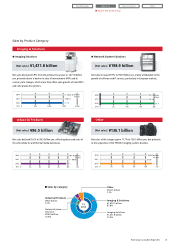Ricoh 2012 Annual Report Download - page 21
Download and view the complete annual report
Please find page 21 of the 2012 Ricoh annual report below. You can navigate through the pages in the report by either clicking on the pages listed below, or by using the keyword search tool below to find specific information within the annual report.
Ricoh Group Sustainability Report 2012 20
Top Message About us Our Activities
The RICOH Way
Data
Promotion of sustainable environmental
management
There are three stages in the Ricoh Group’s environmental conservation
efforts: the Passive Stage, the Proactive Stage, and the Responsible Stage.
In the Passive Stage, we coped with social pressures by dealing with laws
and regulations and competing with other companies. In the Proactive
Stage, we began to take voluntary actions with a sense of mission as a
global citizen. And in the Responsible Stage, our focus is on more than
environmentally friendly business operations. We are striving to achieve
both profits and environmental conservation simultaneously. Specifically,
we develop energy-efficient products, achieve cost reduction through
reduced consumption of energy and resources, develop alternatives for
materials that are at high risk of depletion, improve operational efficiency,
and offer products and solutions for smarter, environmentally friendly work
styles, along with engaging in many more efforts in the course of our day-
to-day operations.
Based on the recognition that we cannot conserve the global
environment or build a sustainable society without reducing total
environmental impact to a level that the Earth’s self-recovery capabilities
can manage, we are actively engaged in forest ecosystem conservation
Environmental Principles
Based on its management philosophy, Ricoh established its Environmental
Principles in 1992. The Principles clearly show the basic policy and action
guidelines that the Group should follow for environmental conservation
and represent the Group’s commitment to sustainable environmental
management, which makes environmental conservation and the creation of
economic value compatible.
Ricoh Group Mid- and Long-Term
Environmental Impact Reduction Goals
The Ricoh Group has set reduction targets in three key areas—energy
conservation and global warming prevention, resource conservation
and recycling, and pollution prevention—under its Mid- and Long-Term
Environmental Impact Reduction Goals. In formulating these goals, we
used the back-casting method, where we first establish final goals, then
determine target values as milestones on the journey toward these goals.
To achieve our established goals, we have been engaged in a range of
activities based on our detailed environmental action plans, which are
formulated every three years.
Environmental Principles www.ricoh.com/environment/management/principles.html
WEB
For more details www.ricoh.com/environment/management/vision.html
Environmental Action Plan www.ricoh.com/environment/management/plan.html
WEB
WEB
activities, in addition to our efforts to reduce our business-related
environmental impact.
Ԃ Three stages in environmental conservation activities (from the passive, to proactive to responsible stage)
Purpose
Activities
Passive Stage Proactive Stage Responsible Stage
Coping with external requirements
• Laws and regulations
• Competition
• Customers
Passive measures to meet laws and
regulations, competing with other
companies, and satisfying customer
needs
1. High-aiming, aggressive activities to
reduce environmental impact
• Energy conservation
• Resource conservation and recycling
• Pollution prevention
2. Improved awareness of all employees
1. Environmental conservation activities
(QCD activities*)
E.g.,: •
Reduced number of parts
•
Reduced number of process steps
•
Improved yield and operation rate
2. Environmental technology development
*
Activities to improve quality, control costs, and manage
delivery times.
Carrying out its mission as a global citizen
• Self-imposed responsibility
• Voluntary planning
• Voluntary activities
Simultaneously achieving environmental
conservation and profits
• Energy conservation and prevention of
global warming
• Resource conservation/Recycling
• Pollution prevention
• Reduction of the impact on biodiversity
• Measures to conserve biodiversity
Activities to reduce
environmental impact
Improvement of the self-recovery
capabilities of the Earth
Environmental impact imposed
by human society
Self-recovery capabilities
of the global environment
Ԃ Keep environmental impact within the self-recovery
capabilities of the Earth
Need to reverse the positions of the two elements
of the see-saw model above as soon as possible
See page 61
Ԃ Ricoh Group Mid- and Long-Term Environmental Impact
Reduction Goals
Reduce the total lifecycle CO2 emissions by the Ricoh Group
by 30% by 2020 and by 87.5% by 2050 from the 2000 level
(1) Reduce the new input of resources by 25% by 2020 and
by 87.5% by 2050 from the 2007 level
(2) Reduce the use of or replace the major materials of
products that are at high risk of depletion (e.g., crude
oil, copper and chromium) by 2050
Energy conservation
and prevention of
global warming
Resource
conservation and
recycling
Pollution prevention
Minimize risks of chemical substances throughout the
product lifecycle by 2020 in compliance with the Strategic
Approach to International Chemicals Management (SAICM)
* Revised in March 2012
























